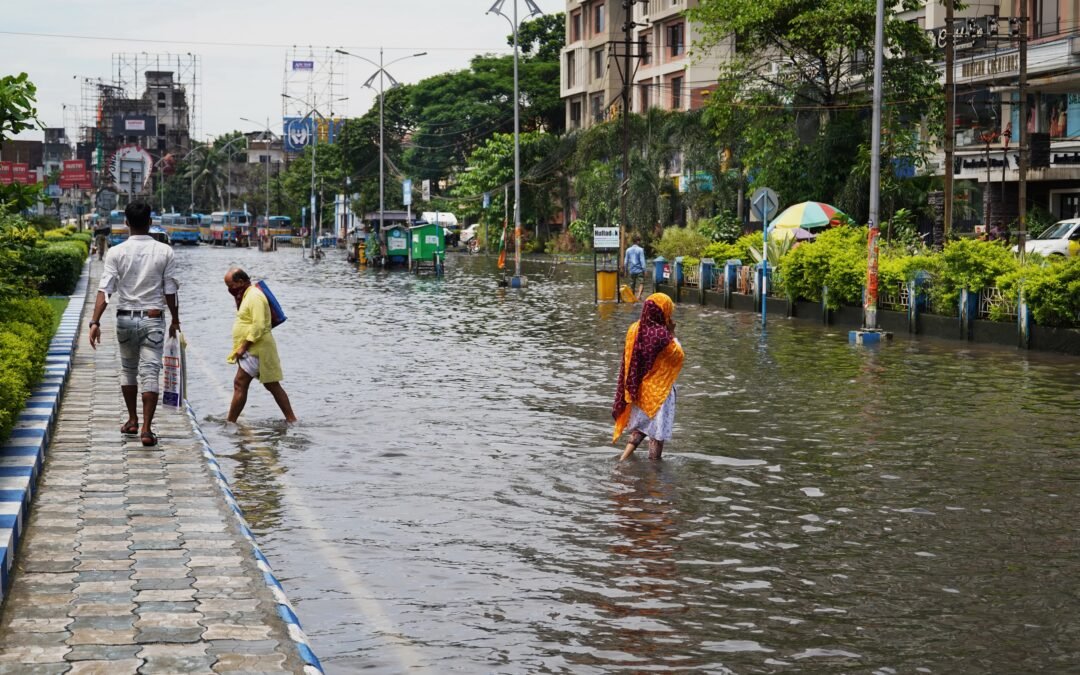Why in the News?
- Every monsoon, Indian cities face severe waterlogging, leading to traffic jams, accidents, and even fatalities.
- Recent focus has shifted to the lack of scientifically designed drainage systems despite clear guidelines by the Indian Roads Congress (IRC) and Ministry of Road Transport and Highways(MoRTH).
Key Highlights
- Waterlogging Crisis in Urban India
- Heavy rain exposes poor drainage infrastructure in metropolitan and suburban areas.
- Example: Gurugram, considered an economic hub, faces massive waterlogging every monsoon.
- IRC and MoRTH Guidelines on Urban Drainage
- IRC and MoRTH have given some codes to design drainage systems in India.
- IRC Codes: IRC:SP:42-2014 (Guidelines on Rural Drainage), IRC:SP:50-2013 (Guidelines on Urban Drainage), IRC:SP-90-2023 (Elevated Structures).
- MoRTH Specifications: Clauses 309 and 704 for surface and subsurface drainage.
- Emphasizes removing both surface and subsurface water to avoid erosion and flooding.
- Key Elements of Effective Drainage (As per IRC)
- Road surface drainage and stormwater management.
- Stormwater drainage systems and appurtenances (e.g., inlets, outlets).
- Subsurface drainage, drainage of special locations, rainwater harvesting, and pumping in low-lying areas.
- Technical Standards and Design Specifications
- Longitudinal Gradient: Minimum 0.50% for pavement drainage; 0.30% for flow inside drains.
- Cross Slope (Camber): Ideal 2% for vehicle stability and quick water dispersal.
- Shoulders & Footpaths: Shoulders sloped steeper than pavement (by 0.5%); footpaths cross-fall 3-4%.
- Hydroplaning Risk: Occurs at speeds of 80-90 kmph with just 2 mm water depth; effective drainage minimizes risk.
- Role of Local Authorities and Coordination
- Roads fall under multiple agencies (NHAI, NHIDCL, PWD), but local bodies must link road drains to the city’s master drainage.
- Lack of coordination between highway agencies and municipal authorities often leads to failure in integrating drainage networks.
Implications
- Public Safety and Urban Mobility
- Waterlogging causes traffic congestion, vehicle breakdowns, and accidents due to hydroplaning.
- Increased risk to pedestrians and commuters during heavy rainfall.
- Economic Impact
- Flooded roads disrupt economic activities and increase transportation costs.
- Infrastructure damage leads to high repair and maintenance expenditure.
- Urban Infrastructure Planning
- Highlights gaps in adherence to IRC and MoRTH guidelines.
- Raises questions about accountability in road construction and drainage design.
- Environmental and Health Concerns
- Stagnant water fosters vector-borne diseases like dengue and malaria.
- Poor stormwater disposal causes erosion and damages ecosystems downstream.
- Governance and Policy Gaps
- Heavy reliance on local authorities without proper resources or planning.
- Absence of integrated drainage master plans for most cities.
Challenges and Way Forward
| Challenges | Way Forward |
| Poor enforcement of IRC and MoRTH guidelines | Make compliance with standards legally mandatory for all road projects |
| Lack of coordination between central agencies and municipal bodies | Establish a unified urban drainage authority or coordination cell |
| Insufficient stormwater management in master plans | Integrate drainage planning in Smart City and AMRUT projects |
| Financial and technical capacity gaps in local bodies | Provide dedicated funding and technical training for municipal engineers |
| Climate change leading to intense rainfall events | Adopt climate-resilient drainage design and green infrastructure solutions (rain gardens, permeable pavements) |
Conclusion
Urban waterlogging in India is not just a seasonal nuisance but a structural problem arising from poor planning and weak execution of drainage systems. Strict implementation of IRC and MoRTH guidelines, improved inter-agency coordination, and climate-resilient infrastructure are essential to ensure safe, functional, and sustainable urban roads. Without systemic reforms, India’s growing cities will continue to drown every monsoon.
| EnsureIAS Mains Question Q. Urban flooding and waterlogging in Indian cities during monsoons is less a natural disaster and more a failure of planning and governance.” Discuss in the context of IRC and MoRTH guidelines on drainage design. (250 Words) |
| EnsureIAS Prelims Question Q. Which of the following statements regarding urban flooding in India is/are correct? 1. The Indian Roads Congress (IRC) guidelines recommend underground stormwater drainage as the primary solution to urban flooding. 2. The Ministry of Housing and Urban Affairs has issued guidelines for rainwater harvesting in all new urban housing projects. 3. Urban flooding is listed as a “notified disaster” under the Disaster Management Act, 2005. Select the correct Option: Answer: b |





